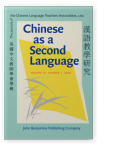Hong Kong Cantonese university students’ tonal errors in Mandarin and their relation to L1 influence
After the change of sovereignty from the United Kingdom to People’s Republic of China, Mandarin has become increasingly
important in Hong Kong society. However, it is observed that many native Cantonese speakers have problems mastering Mandarin tones despite
the less complex tonal system. This study attempts to investigate the Mandarin tonal error patterns made by Hong Kong learners and the
possible causes for these errors. A reading aloud test and a follow-up interview were designed to collect the data. The findings of the
study show that a large number of students were confused about Mandarin tones and found them difficult to master, especially between tone 1
and tone 4 and tone 2 and tone 3. All the participants made these two mistakes in the test. This study hypothesizes that L1 negative
transfer is the key factor that helps Cantonese speaking learners’ ability to establish a new tone in the L2. However, the reason for
participants’ tonal mistakes is not due to one single cause; instead, the errors are caused by multiple factors, including lack of tonal
knowledge, incomplete tonal acquisition, and tonal errors explained by the Speech Learning Model.
Article outline
- 1.Introduction
- 2.Literature review
- 2.1Cantonese and Putonghua tones
- 2.1.1Tone system of Cantonese
- 2.1.2Tone system of Putonghua
- 2.2L1 transfer on L2 acquisition
- 2.3Speech perception models on L2 acquisition
- 3.Methods
- 3.1Participants
- 3.2Instrument
- 3.3Procedure
- Stage 1.Pilot test
- Stage 2.Reading aloud test
- Stage 3.Results comparison and error categorization
- Stage 4.Analysis
- 4.Results
- 4.1Types of tonal errors
- 4.1.1Confusion of tones
- 4.1.2Tone sandhi
- 4.1.3Incomplete pronunciation
- 4.2Interview results
- 5.Discussion
- 5.1Errors explained by speech perception
- 5.2Errors explained by language transfer
- 5.3Teaching implications
- 6.Conclusion
-
References
References (20)
Cao, R.
(
2012)
Perception of Mandarin Chinese Tone 2/ Tone 3 and the role of creaky voice. University of Florida.
[URL]
Chen, H. C., & Han, Q. W.
(
2017)
A corpus-based online Mandarin pronunciation learning system for Cantonese learners: Development, evaluation, and implementation. In
PTLC2017: Proceedings of the Phonetics Teaching and Learning Conference, London, 9–11 August 2017, 30–34. Chandler House.

Chen, H. C., & Han, Q. W.
(
2018)
Designing and implementing a corpus-based online pronunciation learning platform for Cantonese learners of Mandarin.
Interactive Learning Environments, 28(1), 18–31.


Gut, U.
(
2005)
Corpus-based pronunciation training. In
Proceedings of the Phonetics, Teaching and Learning Conference, London.

Hao, Y. C.
(
2012)
Second language acquisition of Mandarin Chinese tones by tonal and non-tonal language speakers.
Journal of phonetics, 40(2), 269–279.


Hao, Y., & Chi, R.
(
2013)
The positive role of L1 in the acquisition of a second language.
Studies in Literature and Language, 7(2), 45–48.

Hong Kong Census and Statistics Department
(
2016)
Thematic household survey report- report No. 59 -pattern of smoking -personal computer and internet penetration – use of language.
[URL]
Ip, K. H.
(
2008)
A phonological analysis of Hong Kong Cantonese secondary students’ errors in Putonghua tones.
HKU Theses Online (HKUTO).

Flege, J. E.
(
2007)
Language contact in bilingualism: Phonetic system interactions. In
Cole, J. &
Hualde, J. I. (eds).
Laboratory Phonology 91, 353–381. Mouton de Gruyter.

Lau, E.
(
2010)
Tone-melody relationship in Cantonese.
Working Papers in Linguistics: University of Hawai’i at Manoa, 41(3), 1–12.

Lau, M. H.
(
2010)
L1 influence on Cantonese as a second language among adult Putonghua-speaking learners in Hong Kong.
HKU Theses Online (HKUTO).

Li, C. N., & Thompson, S. A.
(
1989)
Mandarin Chinese: A functional reference grammar. University of California Press.

Liu, Y.
(
2008)
Error types and sequencing of Putonghua characters by Cantonese area: A quantitative analysis.
Applied linguistics, 21, 67–71.

Matthews, S., & Yip, V.
(
2013)
Cantonese: A comprehensive grammar. Routledge.


Wang, X. C.
(
2013)
Perception of Mandarin tones: The effect of L1 background and training.
The Modern Language Journal, 97(1), 144–160.


Wayland, R. & Guison, S.
(
2004)
Training English and Chinese Listeners to Perceive Thai Tones: A Preliminary Report.
Language LearninCg, 54(4): 681–712.


Yang, B.
(
2015)
Perception and production of Mandarin tones by native speakers and L2 learners. Springer Berlin Heidelberg.


Zhu, H.
(
2002)
Phonological development in specific contexts: Studies of Chinese-speaking children. Multilingual Matters.

Zhang, B.
(
2010)
Language Attitudes of Secondary School Students Towards English, Cantonese and Putonghua in the Context of Post-colonial Hong Kong [Doctoral dissertation]. University of Leicester.

Zhang, X., Samuel, A. G., & Liu, S.
(
2012)
The perception and representation of segmental and prosodic Mandarin contrasts in native speakers of Cantonese.
Journal of Memory and Language, 66(3), 438–457.


Cited by (1)
Cited by 1 other publications
Zhu, Junling
2023.
Critical Literature Review on Teaching Chinese as a World Language in the Context of Globalization.
Language and Sociocultural Theory 9:2

This list is based on CrossRef data as of 4 july 2024. Please note that it may not be complete. Sources presented here have been supplied by the respective publishers.
Any errors therein should be reported to them.
